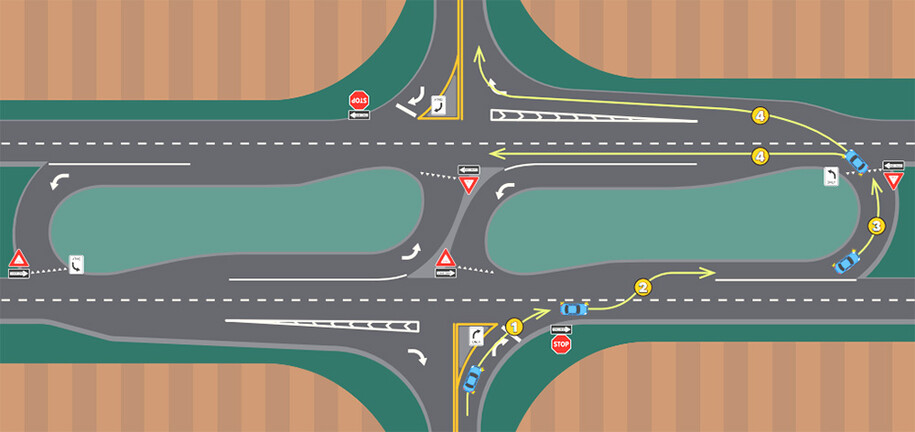Reduced Conflict Intersections (RCI) reduce the number of points where vehicles can inadvertently come into contact with other vehicles, often called conflict points, by 50 percent. A typical four-lane divided highway intersection has 42 possible vehicle conflict points, while reduced-conflict intersections have as few as 24.
Reduced Conflict Intersections improve mobility and greatly reduce the number of severe crashes that can occur when drivers must cross busy divided highways. They decrease fatalities and injuries caused by broadside crashes on four-lane divided highways.
Why Do They Work?
With a Reduced Conflict Intersection, when you are turning from a side street to a four-lane highway, you only have to be concerned with one direction of traffic on the highway at a time. You don’t need to wait for a gap in both directions to cross a major road.
Traditional four-lane divided highway intersections have an elevated risk of severe right-angle crashes (commonly called “T-bone” crashes) when you are crossing all four lanes of traffic. The driver from the side street needs to keep track of traffic in both directions at one time to cross the four-lane divided highway or make a left turn. In a Reduced Conflict Intersection, when vehicles do come into contact with each other, crashes have been shown to significantly reduce the severity of crashes compared to traditional intersections.
How Do They Work?
Drivers on the main road travel through or turn left or right at the intersection like they would at a traditional intersection.
Drivers on the side road wanting to turn left or cross the four-lane divided highway will:
- Turn right onto the main road.
- Merge into the left lane when it is safe to do so.
- Make a left turn at the designated U-turn median opening.
- Continue through the main intersection to complete the left turn or to make a right turn at the main intersection to continue traveling straight on the side road.
The way the pavement is configured, you cannot make a left turn onto the four-lane highway or cross both directions of traffic. This reduces potential conflict points and increases safety.
While this might sound like it will take you longer to turn, generally, the delay caused by a traffic signal or just waiting for traffic to clear at a two-way stopped-controlled intersection is greater than the delay caused by the Reduced Conflict Intersection.
Benefits
- Improved safety. Studies show a 70 percent reduction in fatalities and a 42 percent reduction in injury crashes where a reduced-conflict intersection is used.
- Faster to build. Reduced-conflict intersections can be designed and built in approximately one year. Interchanges typically take 3-5 years and are not practical at all locations.
- Lower cost. Reduced-conflict intersections are often less expensive than constructing and maintaining an intersection with a traffic signal and are a fraction of the cost of building an interchange.
